In the previous article, we discussed the clinical application of cryotherapy. However, would cryotherapy really help in eliminating tumors? Before we use cryotherapy, we should have an understanding of its mechanism.
First of all, I would like to ask everyone a question. Have you ever heard of news reporting something like ‘Russian scientists announced on Wednesday that they found a most well-preserved mammoth body in Siberia in history. Its blood is still flowing, and is meat is still bright red. This stunning discovery greatly increases the likelihood of finding and replicating the living cells of a mammoth. In the coming months, Russian scientists will work with South Korea and the US experts to bring the prehistoric behemoth back on Earth’? (Quate from Apple Daily)
Or do we sometimes see ads of storing stem cells and cord blood? Whether for mammoth or our stem cells and cord blood, it's actually kept the cells at low temperatures. So, would the ‘freezing’ process 'preserve' cells or 'destroy' cells? If it's 'preserving' cells, would we just freeze the tumors in the treatment, and the tumor would recur in a few months?
In fact, the answer for both is right, yet the difference is the methods for freezing and thawing.
Simply put, if we want to preserve cells, we will need to freeze slowly and thaw quickly. For example, if we want to preserve a cell in our lab, the correct way is to put it in a cryo freezing box, locate it in an 80-degree refrigerator overnight, and then store it in liquid nitrogen. Later, when we want to take the cell out for research, we should quickly put it in warm water for a quick thaw.
However, it’s wrong if you did this in tumor treatment! Instead, we must 'freeze quickly and thaw slowly' to drive tumor death from freezing.
Rapid freezing and slow thawing
However, what is the mechanism of 'freezing the tumor to death'? The main point is that when we freeze quickly, the water molecules in the cells will soon form ice crystals and aggregate (crystallization), and these ice crystals will destroy tumor cells like sickles. Meanwhile, the ice crystals will reaggregate (recrystallization) during the slow thawing process and continue destroying tumor cells.
The figures below illustrate the mechanism more clearly.
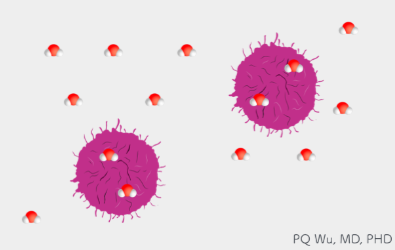
I. At room temperature, water molecules filled inside and outside of the tumor cells.
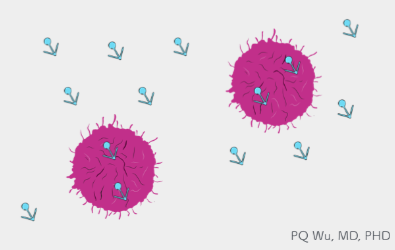
II. When frozen rapidly, the water molecules inside and outside the cell freeze instantly simultaneously.
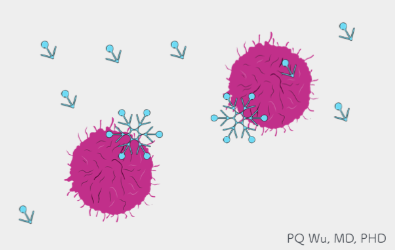
III. When the temperature reaches -40 to -60 degrees Celsius, the ice molecules will aggregate on the cell membrane to form an ice crystal structure.
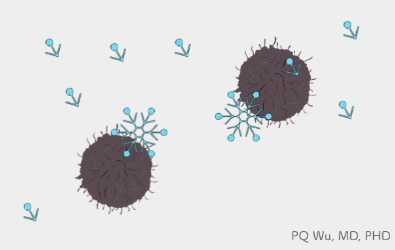
IV. Ice crystals are like sickles and break the tumor cell membrane and drive cell death.
The above principle is at the 'cell' level. However, at the 'tissue' or 'organ' level, cryotherapy can freeze the surrounding blood vessel tissue, whether large or small. We know that the most important function of blood vessels is to bring nutrients to the tissues and organs, and the damage of blood vessels will result in avascular necrosis of tissues and organs. The same will cause ischemia of tumor tissue and let the tumor die!
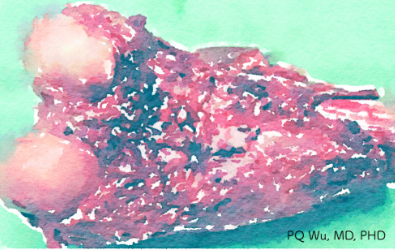
Malignant bone tumor at the distal femur cut off after surgery.
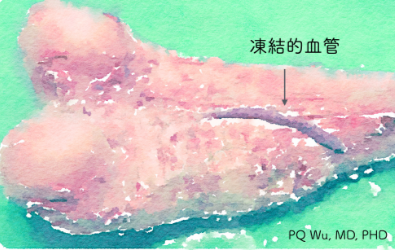
After freezing with liquid nitrogen, all tissues, including the blood vessels that supply the blood flow, were frozen.
Then, you may ask, how cold for cryotherapy is cold enough? The short answer is it depends. Each cell or different tumor in the body had a different threshold for cold, and scientists have been interested in the topic since the 1960s.
According to the study published in the journal Cryobiology by Dr. Gage at the University at Buffalo – SUNY in 2006, general adenocarcinoma, such as common lung adenocarcinoma, colorectal cancer, etc., would require minus 40 degrees Celsius. In malignant osteosarcoma, minus 60 degrees Celsius would be needed, a more stringent condition!
Minus 60 degrees Celsius
Like you, a smart reader may wonder if it’s feasible to take a flight to Alaska or the Arctic to breathe the cold air in the winter to kill the tumor? The answer may be no since, as we just mentioned, 'rapid' cooling of the tumor and slow warming is equally important in addition to low temperatures.
According to scientific studies, 'rapid cooling' is the cooling process of the whole tumor with a rate of at least 20 degrees drop per minute. Slow warming is the warming process with at most 10 degrees rise per minute to bring the entire tumor back to temperature. The above conditions must be met so that good cryotherapy effectiveness can be achieved
However, what kind of material has such a strong ability to cool the tumor? Currently, the most widely used medically is liquid nitrogen!
Orthopedic surgeons have been using liquid nitrogen as a treatment for tumors in recent decades. This is because liquid nitrogen is easy to obtain, and it’s safer since the nitrogen content in the air is high. Yet, how powerful is liquid nitrogen? You can find it out on YouTube!
Meanwhile, let’s take a look at how liquid nitrogen works in our basic experiments.
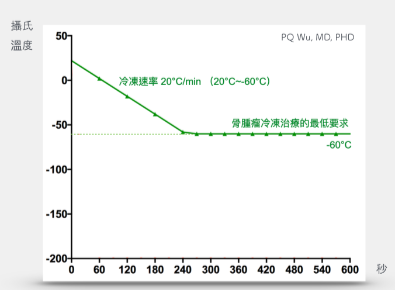
The image on the left is part of our study published in the medical journal CORR. The green line is the minimum temperature requirement for osteosarcoma cryotherapy. That is, the temperature needs to drop to minus 60 degrees, and the freezing rate should be at least 20 degrees per minute. These two requirements are indispensable.
The image on the right simulates the temperature change when the tumor is immersed directly in liquid nitrogen. We can see that within 60 seconds, the temperature of the tumor will drop rapidly from room temperature to minus 196 degrees Celsius, an amazing cooling efficiency!
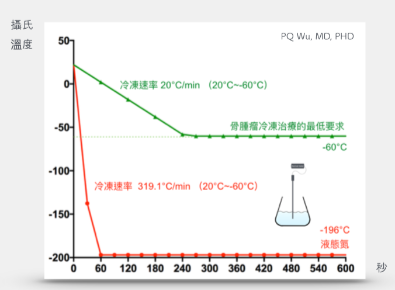
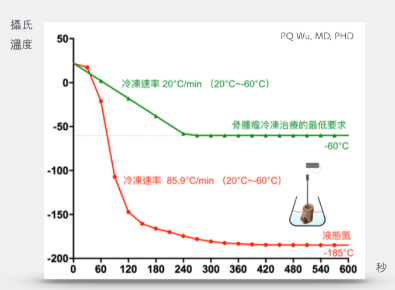
The image on the left simulates the situation where a tumor hides in a bone crevice. We can see that liquid nitrogen can freeze tumors at temperatures and rates that exceed the minimum standards for cryotherapy, even with a 10 mm thickness of bones!
From the above descriptions, we can understand that cryotherapy for osteosarcoma is, in fact, based on much scientific evidence and verification, and it has a long history! Although its effectiveness is good, there are still quite a few ways to improve. The therapeutical and Research Center of Musculoskeletal Tumor at Taipei Veterans General Hospital has invested lots of effort since 2013 to develop many new methods and apply for patents! Many inspiring technologies will likely be invented to provide greater help to patients in the near future!


